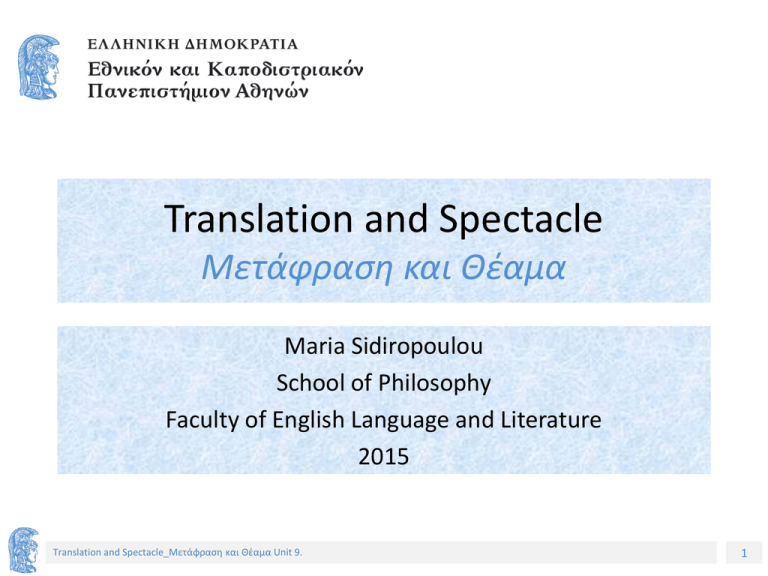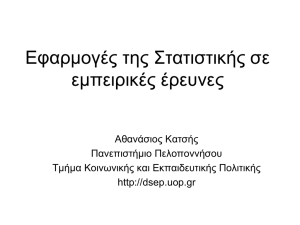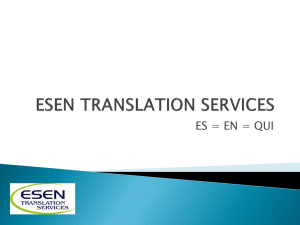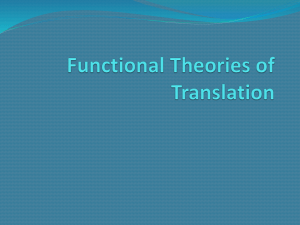
Translation and Spectacle
Μετάφραση και Θέαμα
Maria Sidiropoulou
School of Philosophy
Faculty of English Language and Literature
2015
Translation and Spectacle_Μετάφραση και Θέαμα Unit 9.
1
Source:
Sidiropoulou, Maria.
2012/2013.
Translating Identities on
Stage and Screen –
Pragmatic
perspectives and
discoursal
tendencies.
Newcastle-upon-Tyne:
Cambridge Scholars
http://www.cambridgescholars.com/translating-identities-on-stage-and-screen-18
Translation and Spectacle_Μετάφραση και Θέαμα Unit 9.
2
Maria Sidiropoulou
School of Philosophy
Faculty of English Language and Literature
Unit 9:
Translation Studies perspectives:
linguistic and literary
Translation and Spectacle_Μετάφραση και Θέαμα Unit 9.
3
Aims of unit 9
• To raise awareness of the contribution of
linguistic theory to analyzing spectacle data
• To confirm the three approaches to spectacle
data taken in this course
• To raise awareness of parameters which may
affect translation decision-making in the
spectacle
Translation and Spectacle_Μετάφραση και Θέαμα Unit 9.
4
Contents of unit 9
• Translation and dimensions of context (Hatim
& Mason 1990)
• Approaches to translation data
• Literary texts vs. linguistic tools
• Opera surtitling
• Bourdieu’s symbolic/cultural capital and
translation
Translation and Spectacle_Μετάφραση και Θέαμα Unit 9.
5
Dimensions of context
(adapted from Hatim and Mason 1990:58)
Translation as…
Communicative
transaction
Text
Pragmatic Action
Structure
Texture
Semiotic Interaction
Translation and Spectacle_Μετάφραση και Θέαμα Unit 9.
6
Dimensions of context
Translation as…Communicative transaction
Communicative
transaction
Pragmatic
Action
COMMUNICATIVE TRANSACTION
User: Idiolect,Dialect, etc
Use: Field, Mode, Tenor
Text
Structure
Texture
Semiotic Interaction
Dialect/register rendering, in
English-Greek theatre/film
translation
Issues of social stratification and
class identity in interlingual
transfer, as manifested in
rendering Pygmalion into Greek.
Translation and Spectacle_Μετάφραση και Θέαμα Unit 9.
7
Dimensions of context
Translation as…Pragmatic action
Communicative
transaction
Pragmatic
Action
PRAGMATIC ACTION
Speech Acts, Implicatures
Presuppositions, Text Act etc.
Text
Structure
Texture
Semiotic Interaction
Translation and Spectacle_Μετάφραση και Θέαμα Unit 9.
Rendition of politeness in
another language (as manifested
in translating Pinter) and the
verbal communication styles
(examined in Da and The
Importance of Being Earnest) fall
into the pragmatic dimension of
context.
8
Dimensions of context
Translation as…Semiotic interaction
Communicative
transaction
Pragmatic
Action
Text
Structure
Texture
Semiotic Interaction
Translation and Spectacle_Μετάφραση και Θέαμα Unit 9.
SEMIOTIC INTERACTION
Word, Text, Discourse ,Genre
Intertextuality
The interpretation perspectives
manifested in the translation of
stage versions of Hamlet touch
upon ideological and semiotic
aspects of meaning-making. Part
of the message is transferred
through semiotic systems other
than discourse
9
approaches to translation data
1
2
3
APPROACHES
functionalist
interpretive
critical
RELATED
DISCIPLINES
Social sciences
Psychology
Anthropology
Sociolinguistics
Politics
C.D.A.
METHODS
quantitative
qualitative
textual
Translation and Spectacle_Μετάφραση και Θέαμα Unit 9.
10
The approach in the book vs.
perspectives to intercultural communication
The approach of the book was functionally oriented in that it examined
describable social reality. It had a qualitative and quantitative orientation,
in that it explored systematically occurring variation in mediator
behaviour.
The approach took an interpretive perspective accounting for sociolinguistic
and anthropological variation, as described in intercultural research.
At points, the study drew on critical perspectives to intercultural communication in that it sought to uncover power differentials that affect translation
process and product. It revealed shifts in the power of mediator to
inscribe identities on texts…
APPROACHES
functionalist
interpretive
critical
RELATED
DISCIPLINES
Social sciences
Psychology
Anthropology
Sociolinguistics
Politics
C.D.A.
METHODS
quantitative
qualitative
textual
Translation and Spectacle_Μετάφραση και Θέαμα Unit 9.
11
Literary production vs. linguistic tools
• In the 1980’s, developments in pragmatics and
discourse analysis allowed stylisticians to focus on
the linguistic structure of dramatic dialogue
• In examining issues like politeness, register and
pun rendition, identity inscription and value
implementation, in target texts, the course
extends the potential investigated in the above
research projects to the study of drama and film
dialogue in translation
Translation and Spectacle_Μετάφραση και Θέαμα Unit 9.
12
William Golding’s The Inheritors
• Halliday applied developments in systemic
functional grammar, on Golding’s novel The
Inheritors, to show how ideational patterns
(language used to convey experience and
information about the context) can be used to
imply a specific point of view in prose (Culpeper
et al 1998).
The Inheritors (William Golding)
• http://www.enotes.com/topics/inheritors
• http://en.wikipedia.org/wiki/The_Inheritors_(William_Golding)
Translation and Spectacle_Μετάφραση και Θέαμα Unit 9.
13
John Osborn’s Look back in Anger
Herman (1998) explored the insights of Conversation
Analysis on the study of drama. She examined the
contribution that turn-taking patterns made to
understanding situations and characters in plays. In
analyzing an extract from John Osborn’s Look back in
Anger, she showed that turn-taking choices (e.g.
length of turns, pauses, interruptions etc.) affect the
reader’s interpretation of characters’ discourse.
• Look Back In Anger - 1989 - Kenneth Branagh Emma Thompson
FULL https://www.youtube.com/watch?v=-Jt9ZXgTOEE
Translation and Spectacle_Μετάφραση και Θέαμα Unit 9.
14
Theatre of the Absurd
Simpson (1998) employs linguistic tools for the analysis of
“odd talk”. Odd talk is a clear aspect of absurdity in the
work of a group of dramatists writing in the 1950s and
early 1960s, which critics have called the Theatre of the
Absurd (including Harold Pinter, Eugene Ionesco,
Edward Albee, N.F. Simpson and Samuel Beckett).
Simpson showed that odd talk often “involves taking the
assumptions and patterns from one discourse context
and using them in another where they would not
normally be found” (ibid:34)
Translation and Spectacle_Μετάφραση και Θέαμα Unit 9.
15
Shakespeare’s The Taming of the Shrew
Cooper (1998) employed Grice’s model to show how
we can reconstruct inferential chains that lead to a
particular interpretation, in Shakespeare’s The
Taming of the Shrew. She showed how linguistic
inferences generated via Grice’s model interact with
inferences based on the conventions of a particular
genre (e.g. the farce) and culture (e.g. courtship) to
produce different interpretations (ibid:54).
• Taming of the Shrew - Best Bits
https://www.youtube.com/watch?v=oXUelJZSPxY
Translation and Spectacle_Μετάφραση και Θέαμα Unit 9.
16
Tom Stoppard’s Professional Foul
Bennison (1998) also used developments in discourse
analysis and pragmatics to analyze the behaviour of
characters in Tom Stoppard’s play Professional Foul,
by focusing on four character traits.
• Professional Foul
http://en.wikipedia.org/wiki/Professional_Foul
Translation and Spectacle_Μετάφραση και Θέαμα Unit 9.
17
Scent of a Woman
Culpeper (1998) explores impoliteness in film dialogue
by analysing the behaviour of two main characters in
the film Scent of a Woman. He argued that
impoliteness in the film generates the conflict that
attracts audience attention and moves the plot
forward.
• The Tango - Scent of a Woman (4/8) Movie CLIP (1992) HD
https://www.youtube.com/watch?v=F2zTd_YwTvo
Translation and Spectacle_Μετάφραση και Θέαμα Unit 9.
18
Shakespeare’s Macbeth
Freeman (1998) applied cognitive theory of metaphor
to Shakespeare’s Macbeth. He suggested that the
play is based on the PATH and CONTAINER schemata
and shows how the two schemas interact to create a
four-dimensional image of Macbeth’s downfall.
• MACBETH BBC SHAKESPEARE COLLECTION
https://www.youtube.com/watch?v=lmiEH6E63UM
Translation and Spectacle_Μετάφραση και Θέαμα Unit 9.
19
David Mamet’s Oleanna
Weber (1998) focused on the interaction of the social
context (power relations) and cognitive context
(conceived as “schemata”) to show how our
interpretations of the dialogue are affected by our
assumptions. Weber discussed changing power
relations between a university teacher and a student
in David Mamet’s Oleanna to identify three models of
power relations.
• [Full Movie] Oleanna (1994)
https://www.youtube.com/watch?v=P2KFG4ZibCQ
Translation and Spectacle_Μετάφραση και Θέαμα Unit 9.
20
Arthur Miller’s The Crucible
Lowe (1998) employed Austin and Searle’s speech act
theory to analyze ‘unhappy’ confessions in Arthur
Miller’s The Crucible. Lowe showed how the
discourses of two characters in the play are
interpreted differently by the other characters and
the reader.
• The Crucible
https://www.youtube.com/watch?v=o3hDrTAmDH0
Translation and Spectacle_Μετάφραση και Θέαμα Unit 9.
21
Opera surtitling
Jacques Offenbach’s Les Contes d’ Hoffmann
Greek surtitles by P. Christogiannopoulou, National Opera House, Athens
Offenbach, J.
Les Contes
d’Hoffmann
Eh! Eh! Sage, modeste et belle! (à part) Je retrerai
par elle, dans les cinq cents ducats que la
banqueroute du juif Elias me coûte!
Offenbach, J.
The Tales of
Hoffmann
Ho ho! Obedient, modest and beautiful! (aside)
Thanks to her I’ll be able to make up the five
hundred ducats that I’ve lost through Elias the
Jew’s bankruptcy!
Ζ. Όφενμπαχ
Τα Παραμύθια του
Χόφμαν
Translation and Spectacle_Μετάφραση και Θέαμα Unit 9.
Φρόνιμη, σεμνή και όμορφη. Μ’ αυτήν θα
ξαναπάρω τα πεντακόσια δουκάτα που μου
στοίχισε η χρεωκοπία του εβραίου Ελιάς
22
Bourdieu’s symbolic/cultural capital
Hermans (1999) describes Gouanvic’s attempt [1997] to account for
the status and prestige (‘symbolic/cultural capital’ in Bourdieu’s
sense) of cultural products when they enter a new environment
through translation
By ‘cultural capital’, he means all three forms of it, in Bourdieu’s sense,
namely,
• the “long-lasting dispositions of the mind and body” (embodied
form, ibid: 82),
• the cultural goods available, like pictures, books, instruments,
dictionaries etc (objectified form), and
• the objectification obtained through educational qualifications
(institutionalized form).
Translation and Spectacle_Μετάφραση και Θέαμα Unit 9.
23
Unit 9 has …
• raised awareness of the contribution of
linguistic theory to analyzing spectacle data
• confirmed the three approaches to spectacle
data taken in this course
• raised awareness of parameters which may
affect translators’ decision-making in the
spectacle
Translation and Spectacle_Μετάφραση και Θέαμα Unit 9.
24
References 1/2
•
•
•
•
•
•
•
•
•
•
•
Attardo, Salvatore. 2001. Humorous Texts: A Semantic and Pragmatic Analysis. Berlin/New York: Mouton
de Gruyter.
Baker, Mona. 2006. Translation and Conflict – A Narrative Account. London: Routledge.
Bassnett, Susan. 1998. “Researching Translation Studies” in Bush, Peter and Kirsten Malmkjær (eds)
Rimbaud’s Rainbow. 105-118. Amsterdam: John Benjamins.
Bennison, N. 1998. “Accessing Character through Conversation: Tom Stoppard’s Professional Foul” in
Culpeper Jonathan, Short Mick and Peter Verdonk (eds) Exploring the Language of Drama. 67-82. London:
Routledge.
Brown, Penelope and Stephen Levinson. 1978/1987. Politeness: Some universals in Language Usage.
Cambridge: Cambridge University Press.
Brown, Roger and Albert Gilman. 1989. “Politeness theory and Shakespeare’s four major tragedies”.
Language in Society. 18: 2. 159-212.
Chesterman, Andrew. 1997. Memes of Translation. Amsterdam: John Benjamins.
Culpeper, Jonathan. 1998. “(Im)politeness in Dramatic Dialogue” in Culpeper Jonathan, Short Mick and
Peter Verdonk (eds) Exploring the Language of Drama. 83-95. London: Routledge.
Freeman, Donald C. 1995. “‘Catch[ing] the nearest way’: Macbeth and Cognitive Metaphor” in Culpeper
Jonathan, Short Mick and Peter Verdonk (eds) Exploring the Language of Drama. 96-111. London:
Routledge.
Gibbs, A. M. 1983. The Art and Mind of Shaw. London: MacMillan.
Grene, Nicholas. 1984/1987. Bernard Shaw – A Critical View. London: Mac Millan.
Translation and Spectacle_Μετάφραση και Θέαμα Unit 9.
25
References 2/2
•
•
•
•
•
•
•
•
•
•
•
Gudykunst, William B., and Stella Ting-Toomey. 1988. Culture and Interpersonal Communica-tion. Newbury
Park, CA: Sage.
Hale, Terry and Carole-Anne Upton. 2000. “Introduction” in Upton Carole-Anne (ed) Moving Target –
Theatre Translation and Cultural Relocation. 1-13. Manchester: St. Jerome.
Hatim, Basil and Ian Mason. 1990. Discourse and the Translator. London and New York: Longman.
Hermans, Theo. 1999. Translation in Systems – Descriptive and System oriented Approaches Explained.
Manchester: St Jerome.
Katan, David. 1999. Translating Cultures. An Introduction for Translators, Interpreters and Mediators.
Manchester: St Jerome.
Lefevere, Andre. 1998. “Acculturating Bertolt Brecht” in Bassnett, Susan and Andre Lefevere (eds)
Constructing Cultures – Essays on Literary Translation. 109-122. Clevedon: Multilingual Matters.
Lowe, Valerie. 1998. “‘Unhappy’ Confessions in The Crucible: a Pragmatic Explanation” in Culpeper
Jonathan, Short Mick and Peter Verdonk (eds) Exploring the Language of Drama. 128-141. London:
Routledge.
Sidiropoulou Maria. Translating Identities on Stage and Screen. Pragmatic perspectives and discoursal
tendencies. Newcastle-upon-Tyne: Cambridge Scholars.
Simpson Paul. 1998. “Odd Talk: Studying Discourses of Incongruity” in Culpeper Jonathan, Short Mick and
Peter Verdonk (eds) Exploring the Language of Drama. 34-53. London: Routledge.
Smith, S. 1998. “The Language of Subtitling” in Gambier, Yves (ed) Translating for the Media. 139-149.
Turku: Centre for Translation and Interpreting, University of Turku.
Stephens, John. 1992. Language and Ideology in Children’s Fiction. London: Longman.
Translation and Spectacle_Μετάφραση και Θέαμα Unit 9.
26
Χρηματοδότηση
• Το παρόν εκπαιδευτικό υλικό έχει αναπτυχθεί στo πλαίσιo του
εκπαιδευτικού έργου του διδάσκοντα.
• Το έργο «Ανοικτά Ακαδημαϊκά Μαθήματα στο Πανεπιστήμιο Αθηνών»
έχει χρηματοδοτήσει μόνο την αναδιαμόρφωση του εκπαιδευτικού
υλικού.
• Το έργο υλοποιείται στο πλαίσιο του Επιχειρησιακού Προγράμματος
«Εκπαίδευση και Δια Βίου Μάθηση» και συγχρηματοδοτείται από την
Ευρωπαϊκή Ένωση (Ευρωπαϊκό Κοινωνικό Ταμείο) και από εθνικούς
πόρους.
Translation and Spectacle_Μετάφραση και Θέαμα Unit 9.
27
Σημειώματα
Translation and Spectacle_Μετάφραση και Θέαμα Unit 9.
28
Σημείωμα Ιστορικού Εκδόσεων Έργου
Το παρόν έργο αποτελεί την έκδοση 1.0.
Έχουν προηγηθεί οι κάτωθι εκδόσεις:
• --
Translation and Spectacle_Μετάφραση και Θέαμα Unit 9.
29
Σημείωμα Αναφοράς
Copyright Εθνικόν και Καποδιστριακόν Πανεπιστήμιον Αθηνών, Μαρία
Σιδηροπούλου. «Μετάφραση και Θέαμα». Έκδοση: 1.0. Αθήνα 2014.
Διαθέσιμο από τη δικτυακή διεύθυνση:
http://opencourses.uoa.gr/courses/ENL3/.
Translation and Spectacle_Μετάφραση και Θέαμα Unit 9.
30
Σημείωμα Αδειοδότησης
Το παρόν υλικό διατίθεται με τους όρους της άδειας χρήσης Creative Commons
Αναφορά, Μη Εμπορική Χρήση Παρόμοια Διανομή 4.0 [1] ή μεταγενέστερη, Διεθνής
Έκδοση. Εξαιρούνται τα αυτοτελή έργα τρίτων π.χ. φωτογραφίες, διαγράμματα
κ.λ.π., τα οποία εμπεριέχονται σε αυτό και τα οποία αναφέρονται μαζί με τους
όρους χρήσης τους στο «Σημείωμα Χρήσης Έργων Τρίτων».
[1] http://creativecommons.org/licenses/by-nc-sa/4.0/
Ως Μη Εμπορική ορίζεται η χρήση:
• που δεν περιλαμβάνει άμεσο ή έμμεσο οικονομικό όφελος από την χρήση του έργου, για
το διανομέα του έργου και αδειοδόχο
• που δεν περιλαμβάνει οικονομική συναλλαγή ως προϋπόθεση για τη χρήση ή πρόσβαση
στο έργο
• που δεν προσπορίζει στο διανομέα του έργου και αδειοδόχο έμμεσο οικονομικό όφελος
(π.χ. διαφημίσεις) από την προβολή του έργου σε διαδικτυακό τόπο
Ο δικαιούχος μπορεί να παρέχει στον αδειοδόχο ξεχωριστή άδεια να χρησιμοποιεί το έργο για
εμπορική χρήση, εφόσον αυτό του ζητηθεί.
Translation and Spectacle_Μετάφραση και Θέαμα Unit 9.
31
Διατήρηση Σημειωμάτων
Οποιαδήποτε αναπαραγωγή ή διασκευή του υλικού θα πρέπει
να συμπεριλαμβάνει:
το Σημείωμα Αναφοράς
το Σημείωμα Αδειοδότησης
τη δήλωση Διατήρησης Σημειωμάτων
το Σημείωμα Χρήσης Έργων Τρίτων (εφόσον υπάρχει)
μαζί με τους συνοδευόμενους υπερσυνδέσμους.
Translation and Spectacle_Μετάφραση και Θέαμα Unit 9.
32
Σημείωμα Χρήσης Έργων Τρίτων (1/2)
Το Έργο αυτό κάνει χρήση των ακόλουθων έργων:
Εικόνες/Σχήματα/Διαγράμματα/Φωτογραφίες
Εικόνα 1: Book cover: Sidiropoulou Maria, 2012/2013, Translating Identities on
Stage and Screen – Pragmatic perspectives and discoursal tendencies, Newcastleupon-Tyne: Cambridge Scholars. Copyright © 2015 Cambridge Scholars Publishing.
All rights reserved. http://www.cambridgescholars.com/translating-identities-onstage-and-screen-18.
Translation and Spectacle_Μετάφραση και Θέαμα Unit 9.
33
Σημείωμα Χρήσης Έργων Τρίτων (2/2)
Το Έργο αυτό κάνει χρήση των ακόλουθων έργων:
Πίνακες
Translation and Spectacle_Μετάφραση και Θέαμα Unit 9.
34







